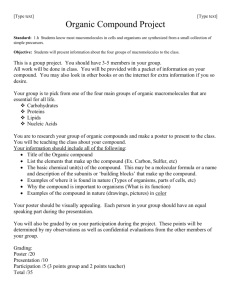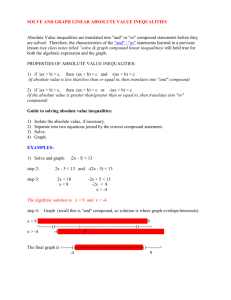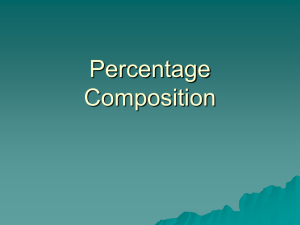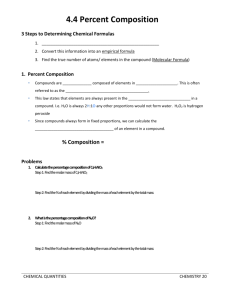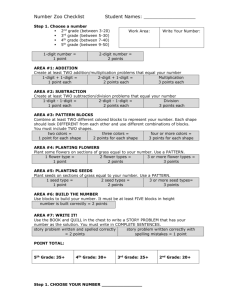Weekly Update May 4-8 Reminders: We will be MAP Testing this
advertisement
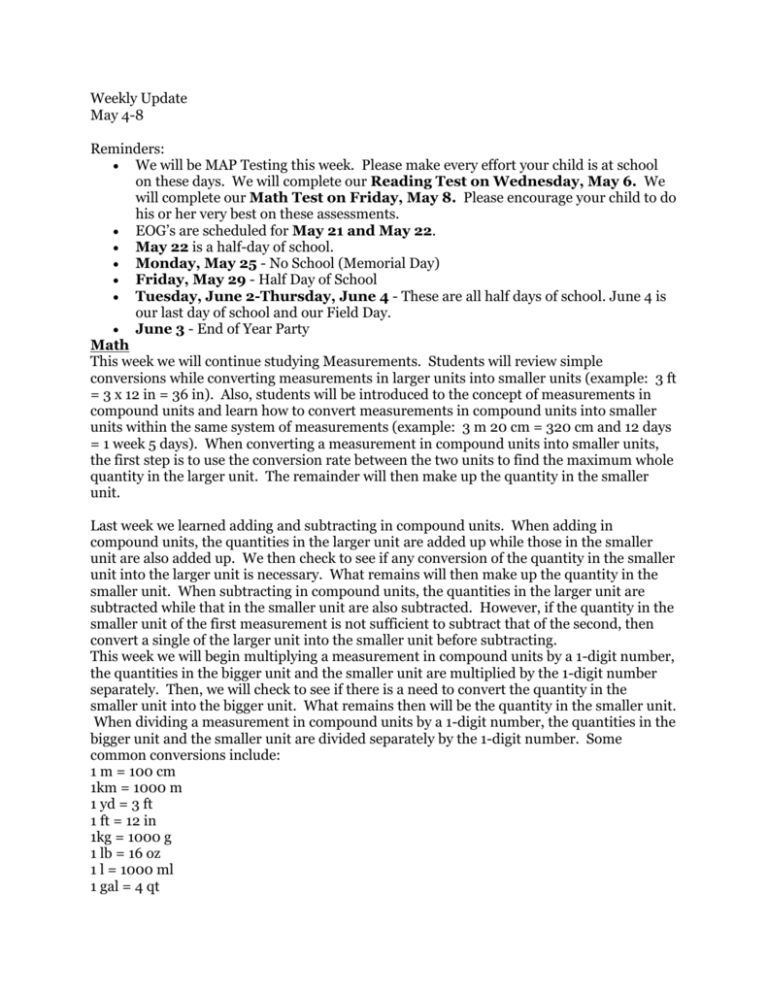
Weekly Update May 4-8 Reminders: We will be MAP Testing this week. Please make every effort your child is at school on these days. We will complete our Reading Test on Wednesday, May 6. We will complete our Math Test on Friday, May 8. Please encourage your child to do his or her very best on these assessments. EOG’s are scheduled for May 21 and May 22. May 22 is a half-day of school. Monday, May 25 - No School (Memorial Day) Friday, May 29 - Half Day of School Tuesday, June 2-Thursday, June 4 - These are all half days of school. June 4 is our last day of school and our Field Day. June 3 - End of Year Party Math This week we will continue studying Measurements. Students will review simple conversions while converting measurements in larger units into smaller units (example: 3 ft = 3 x 12 in = 36 in). Also, students will be introduced to the concept of measurements in compound units and learn how to convert measurements in compound units into smaller units within the same system of measurements (example: 3 m 20 cm = 320 cm and 12 days = 1 week 5 days). When converting a measurement in compound units into smaller units, the first step is to use the conversion rate between the two units to find the maximum whole quantity in the larger unit. The remainder will then make up the quantity in the smaller unit. Last week we learned adding and subtracting in compound units. When adding in compound units, the quantities in the larger unit are added up while those in the smaller unit are also added up. We then check to see if any conversion of the quantity in the smaller unit into the larger unit is necessary. What remains will then make up the quantity in the smaller unit. When subtracting in compound units, the quantities in the larger unit are subtracted while that in the smaller unit are also subtracted. However, if the quantity in the smaller unit of the first measurement is not sufficient to subtract that of the second, then convert a single of the larger unit into the smaller unit before subtracting. This week we will begin multiplying a measurement in compound units by a 1-digit number, the quantities in the bigger unit and the smaller unit are multiplied by the 1-digit number separately. Then, we will check to see if there is a need to convert the quantity in the smaller unit into the bigger unit. What remains then will be the quantity in the smaller unit. When dividing a measurement in compound units by a 1-digit number, the quantities in the bigger unit and the smaller unit are divided separately by the 1-digit number. Some common conversions include: 1 m = 100 cm 1km = 1000 m 1 yd = 3 ft 1 ft = 12 in 1kg = 1000 g 1 lb = 16 oz 1 l = 1000 ml 1 gal = 4 qt 1 qt = 2 pt 1pt = 2 c 1 year = 12 months 1 week = 7 days 1 day = 24 hours 1 hr = 60 min 1 min = 60s 1 mile = 5280 feet 1 ton = 2000 lbs. Students have taken notes on these in their math journals. They should be studying these conversions nightly. CKLA This week, we will begin studying American Reformers. In this unit, we will study American men and women who changed our country for the better. Dorothea Dix worked very hard to help make improvements for our mentally ill. We will also study Horace Mann, who led the movement to provide free public school education for all. William Lloyd Garrison used his newspaper to inform people about the evils of slavery. Angelina and Sarah Grimke were sisters who started out advocating in the abolitionist movement, and then saw the need advocate for women’s rights. We will talk about the Seneca Falls Convention and the roles of Lucretia Mott and Elizabeth Cady Stanton in this important event. We will also discuss Sojourner Truth, a former slave, who was an instrumental voice in the women’s rights movement. Students will also begin several of our End-of-Year assessments provided by our CKLA program. The assessments this week will focus on Reading Comprehension skills. Grammar/Morphology We will begin to review the concepts that we have learned this year in preparation for our End-of-Year Grammar Assessment. Students will be reviewing the following concepts: declarative, interrogative, imperative and exclamatory sentences and the correct punctuation for each identifying the subject and predicate within a sentence common and proper nouns adverbs adjectives helping verbs progressive forms of helping verbs commas and commas in a series using quotation marks Core We will continue our Meteorology unit this week. In this unit, the students will: ● discuss the difference between “weather” and “climate” ● learn about the 6 types of climates ● review the water cycle ● determine the difference among cloud types ● learn about the different layers of our atmosphere ● learn about air movement and how it affects the weather ● discuss cold and warm fronts and what type of weather we can expect from each We will also have a special visit from WLOS Meteorologist Karen Wynne. She will be coming to speak to the children on Wednesday at 1:30. Spelling Our spelling words come from our Meteorology Unit. They are as follows: 1. lightning 2. thunder 3. tornado 4. wind 5. cumulus 6. stratus 7. cirrus 8. barometer 9. anemometer 10. humidity 11. Greenhouse Effect 12. air pressure





